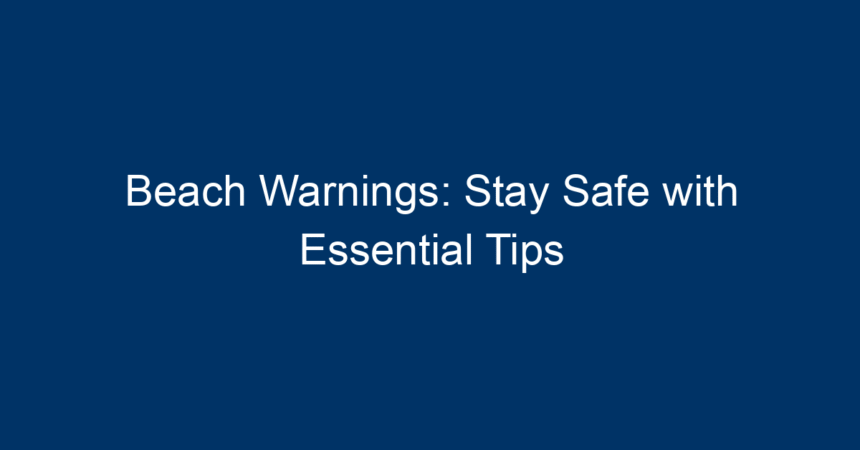As summer approaches and the allure of sun-kissed sands beckons, understanding beach warnings becomes paramount for safety. Beaches offer a recreational haven, but they also harbor risks that can turn a sunny day into a perilous experience. This guide provides essential tips for navigating beach warnings and ensuring safety while enjoying your seaside escapes.
Why Beach Warnings Matter
Every year, thousands flock to beaches worldwide, drawn by the allure of sun, surf, and relaxation. However, the ocean is unpredictable. Beach warnings are crucial indicators of potential hazards, ranging from rip currents to high surf conditions. By staying informed and vigilant, you can protect yourself and your loved ones from danger.
Common Beach Warnings Explained
Understanding the types of beach warnings is the first step in ensuring a safe beach experience. Below are the most common warnings you may encounter:
1. Rip Current Warnings
What They Are: Rip currents are fast-moving channels of water that flow away from the shore. They can be deceptively strong, posing a serious threat to swimmers.
How to Identify: Look for waves breaking farther out to sea, a difference in water color, or foam and debris moving seaward.
Safety Tips:
- Stay calm if caught in a rip current. Swim parallel to the shore until you’re free, then swim back to safety.
- Always keep an eye on younger swimmers and ensure they understand the danger of rip currents.
2. High Surf Advisories
What They Are: High surf conditions can lead to dangerous wave heights that make swimming hazardous.
When You’ll See These Warnings: Typically issued during storms or when strong winds affect the ocean’s surface.
Safety Tips:
- Avoid swimming during high surf advisories.
- Opt for safer beach activities like building sandcastles or beachcombing.
3. Beach Hazards Statements
What They Are: These statements cover various threats like jellyfish, stingrays, or shark activity.
How to Approach: If you see a beach hazards statement, stay informed through local news or social media channels for updates.
Safety Tips:
- Wear protective footwear when walking in the water to avoid jellyfish or stingray stings.
- Be cautious and informed about local wildlife.
Preparing for a Safe Beach Trip
Being prepared is essential for enjoying a beach day safely. Here are some considerations to keep in mind before you head out:
1. Research Local Conditions
Before you leave home, check for local beach warnings and weather conditions. Websites and apps can provide real-time updates about rip currents, water temperature, and more.
2. Bring Safety Gear
Make sure to pack safety essentials such as:
- Life jackets for children.
- A first aid kit for minor injuries.
- Sunscreen to protect against sunburn.
3. Stay with a Buddy
Never swim alone. Having a trusted friend or family member by your side is not only more enjoyable, but it significantly enhances safety.
4. Know Your Limits
Be aware of your swimming abilities and the conditions of the water. If you’re a beginner, stick to shallow waters and avoid areas marked with warnings.
Interpreting Beach Signage
Beach signage is there for your protection. Understanding the meaning behind various signs can increase your awareness.
1. Colored Flags
Many beaches use a flag system to convey warnings:
- Green Flag: Low hazard, safe to swim.
- Yellow Flag: Medium hazard; exercise caution.
- Red Flag: High hazard; swimming is not advisable.
- Purple Flag: Dangerous marine life present.
Always observe the flags before entering the water and heed their warnings.
2. Informational Boards
Take a moment to read the informational boards at each beach. They offer critical updates on local weather, wildlife alerts, and specific beach rules.
In Case of Emergency
Despite all precautions, emergencies can still happen. Knowing how to respond is crucial.
1. Understanding Lifeguard Protocols
In beaches equipped with lifeguards, be aware of their signals and instructions. They are trained to handle emergencies, so if you see someone in distress, alert a lifeguard immediately.
2. Performing First Aid
Basic first aid knowledge can be invaluable:
- For a stingray sting, soak the affected area in hot water.
- For jellyfish stings, rinse with seawater and remove tentacles with tweezers (not your hands).
If someone is unresponsive, call for help right away and begin CPR if trained to do so.
Tips for Families
For families with young kids, beach safety requires extra caution and preparation.
1. Supervise Children
Always keep a close eye on children. Use designated swimming areas and make sure they understand water safety.
2. Teach About Beach Warnings
Educate your kids about various beach warnings. Knowledge empowers them to make smart choices.
3. Plan Activities Around the Weather
If rain or storms are forecast, consider postponing your outing. Rescheduling is better than risking the safety of your family.
Concluding Thoughts
As you plan your next beach outing, remember that vigilance is key. Beach warnings serve as essential guidelines to keep you safe from the dangers inherent in the beautiful, yet unpredictable, ocean. Always stay informed, respect nature’s forces, and prioritize safety above all else.
By taking these proactive steps, you can focus on what truly matters — making lasting memories with family and friends without compromising safety. Enjoy your time under the sun, and don’t forget to keep an eye on those beach warnings!
Actionable Insights
- Check local beach warnings online before heading to the beach.
- Pack essential safety gear and familiarize yourself with beach signage.
- Educate your family about beach safety and emergency procedures.
- Always swim in designated areas and keep a watchful eye on children.
Final Thoughts
Summer is a time for fun, relaxation, and adventure. With the right precautions and a respect for beach warnings, you can create unforgettable experiences while ensuring your safety and that of your loved ones. So pack your bags, grab your sunscreen, and enjoy everything the beach has to offer — safely!




